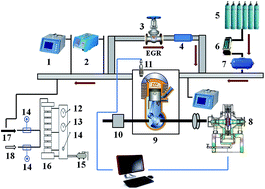Impact of EGR on the surface functional groups of diesel engine particles based on NEXAFS
Abstract
The thermal, dilution and chemical effects of EGR result in relatively significant changes in the formation environment, in the physical and chemical reactions of particles and in the functional groups of the matter that constitutes the particles. In this paper, the surface functional groups of particles generated from a diesel engine (2000 rpm, 2.6 kW) under different EGR rates (0, 10%, 30%), EGR gas composition (CO2, N2) and EGR temperature (423 K, 373 K, 323 K) was studied by near-edge X-ray absorption fine-structure (NEXAFS) spectroscopy. The near-edge energy of the C functional groups of diesel engine particles are mainly distributed at the near energy range of 284–292 eV, and these C functional groups exhibited a typical graphite structure. The content of the O-lacking functional groups of particles gradually decreased with increases in the EGR rate, whereas the contents of the O-containing functional groups and the aliphatic C–H functional group increased with increases in the EGR rate. The presence of CO2 in the exhaust gas caused the content of the O-containing and aliphatic C–H functional groups of particles to increase, whereas the contents of the O-lacking functional groups decreased. The presence of N2 had an insignificant impact on the relative content of the functional groups. The content of the O-lacking functional groups increased significantly with increases in the EGR temperature, whereas the content of the O-containing and aliphatic C–H functional groups all decreased to some extent with increases in the EGR temperature.


 Please wait while we load your content...
Please wait while we load your content...